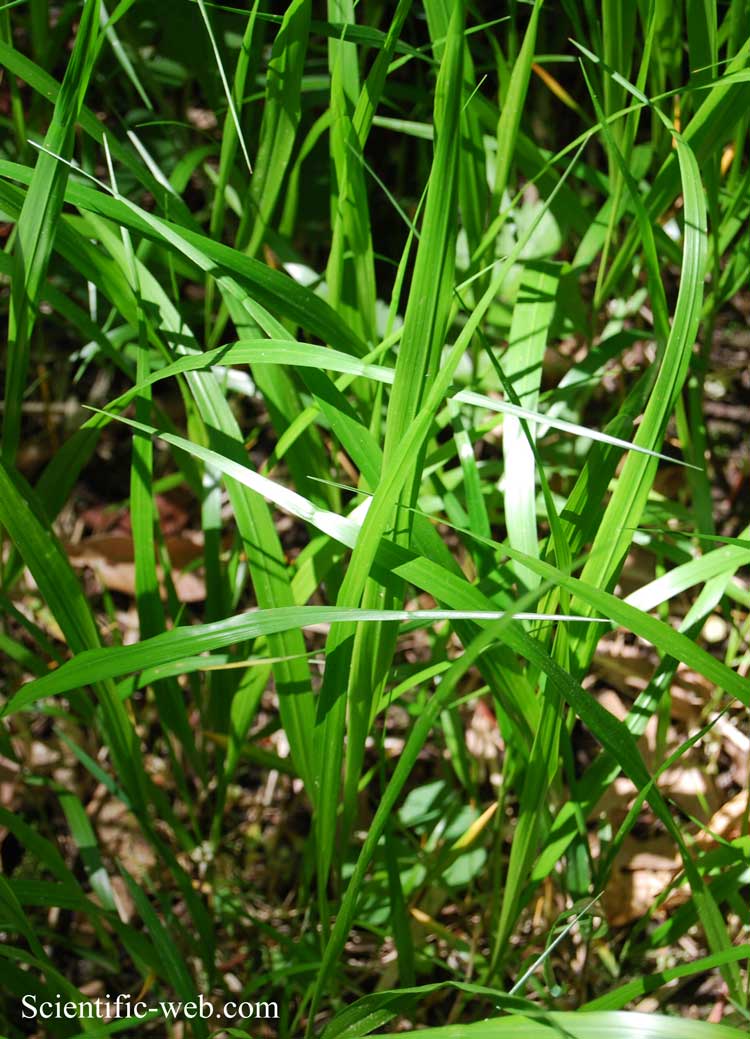
Diarrhena americana, Photo: Michael Lahanas
Classification System: APG IV
Superregnum: Eukaryota
Regnum: Plantae
Cladus: Angiosperms
Cladus: Monocots
Cladus: Commelinids
Ordo: Poales
Familia: Poaceae
Subfamilia: Pooideae
Tribus: Diarrheneae
Genus: Diarrhena
Species: Diarrhena americana
Name
Diarrhena americana P.Beauv. , Ess. Agrostogr.: 142 (1812)
Type species:
Synonyms
Basionym
Festuca diandra Michx., Fl. Bor.-Amer. 1: 67 (1803), nom. illeg.
Homotypic
Diarina festucoides Raf., Med. Repos. 5: 352 (1808), nom. superfl.
Diarina sylvatica Raf., J. Phys. Chim. Hist. Nat. Arts 89: 104 (1819), nom. superfl.
Diarrhena diandra Alph.Wood, Class-book Bot., ed. 2a: 612 (1847), nom. superfl.
Korycarpus diandrus Kuntze, Revis. Gen. Pl. 2: 772 (1891), nom. superfl.
Diarrhena festucoides (Raf.) Fernald, Rhodora 34: 204 (1932), nom. illeg.
Heterotypic
Festuca americana Michx. ex P.Beauv., Ess. Agrostogr.: 162 (1812), nom. inval.
Korycarpus arundinaceus Zea ex Lag., Gen. Sp. Pl.: 4 (1816).
Roemeria Roem. & Schult., Syst. Veg. 1: 61 (1817), nom. illeg.
Roemeria zeae Roem. & Schult., Syst. Veg. 1: 287 (1817).
Neomolinia Honda & Sakisaka, J. Fac. Sci. Univ. Tokyo, Sect. 3, Bot. 3: 110 (1930).
Diarrhena arundinacea (Zea ex Lag.) Rydb., Fl. Plains N. Amer.: 114 (1932).
References
Palisot de Beauvois, A.M.F.J. (1812) Essai d'une Nouvelle Agrostographie; ou Nouveaux Genres des Graminées; Avec Figures Représentant les Caractéres de tous le Genres. Imprimerie de Fain. Paris 142, t. 25.
Flora of North America Editorial Committee (2007) Flora of North America North of Mexico 24: 1–908. Oxford University Press, New York, Oxford.
Lea, C. (2012) Diarrhena obovata in the Potomac River Watershed: A new invader?. Castanea 77: 172–178.
USDA, ARS, Germplasm Resources Information Network. Diarrhena americana in the Germplasm Resources Information Network (GRIN), U.S. Department of Agriculture Agricultural Research Service. Accessed: 08-Apr-12.
Diarrhena americana, also known as American beak grass or American beakgrain, is a native, perennial bunchgrass of North America.[2][3]
Historically, Diarrhena americana was the only species of beak grass recognized in the United States; however studies have suggested that the known beak grass is to be classified into two distinct species, Diarrhena americana and Diarrhena obovata.[4]
Distribution
Diarrhena americana naturally occurs throughout the Midwestern United States, including in eastern Oklahoma and Missouri; south to Alabama; east to Kentucky, the Appalachian Mountains and northern Maryland; and north to southern Illinois, Indiana, Ohio, and southern Michigan.[2][5][6]
The grass plant lives in rich cove forests and woodlands, preferring to grow in the moist soils of shaded ledges and riverbanks.[7] It grows in rich, moist woodlands from Missouri to Maryland and south to Oklahoma and Alabama.[2]
Description
In cultivation at the Berlin Botanical Garden
Diarrhena americana is a bunchgrass that grows in 2–3 feet (0.61–0.91 m) tall clumps. It has bright green leaf blades, that can grow up to 0.75 inches (1.9 cm) in width.[2]
These perennial plants can grow flowers that grow above the foliage, with 3 inch tall floral spikes, during the early to mid-summer. The culms range from 60–131 cm (24–52 in) high.[2][8][8]
By late summer the flowers turn into hard, brown seed heads.[2] Each seed is reduced to a blunt beak, which is where the common name of beak grass comes from, and this beak is dispersed.[8]
Cultivation
Diarrhena americana is cultivated as an ornamental grass, grown in traditional and wildlife gardens, and in natural landscaping projects.[8]
It is considered an easy plant to grow and maintain, not needing much sun or water while generally being a tough plant. It will tolerate drought, heavy shade, competition from eastern black walnuts, and urban air pollution.[8] When available, the plant will grow into dense clumps in moist rich soils in full shade.[8]
Conservation
Diarrhena americana is a listed endangered species in Maryland and Wisconsin, and a threatened species in Michigan.[3]
References
Hitchcock, A.S. (rev. A. Chase). 1950. Manual of the grasses of the United States. USDA Miscellaneous Publication No. 200. Washington, DC.
"Utah State University: Intermountain Herbarium". Archived from the original on June 11, 2011. Retrieved June 5, 2010.
"Diarrhena americana 'Beauv.'" (PDF). Retrieved May 30, 2009.
Brandenburg, D.M., J.R. Estes, and S.L. Collins. (1991). "A Revision of Diarrhena (Poaceae) in the United States" (PDF). Torrey Bot. Club. Retrieved January 28, 2019.
"The Grass Manual on the Web.edu: Distribution map for Diarrhena americana". Archived from the original on April 28, 2014. Retrieved May 18, 2017.
"Beak Grass Diarrhena obovata". Retrieved January 28, 2019.
"Diarrhena americana Beauv". Retrieved January 28, 2019.
"Diarrhena americana". Retrieved 2014-04-25.
Koyama, T. and S. Kawano. 1964. Critical taxa of grasses with North American and eastern Asiatic distribution. Can. J. Bot. 42:859–864.
Tateoka, T. 1960. Cytology in grass systematics: A critical review. Nucleus (Calcutta) 3:81–110.
Retrieved from "http://en.wikipedia.org/"
All text is available under the terms of the GNU Free Documentation License

